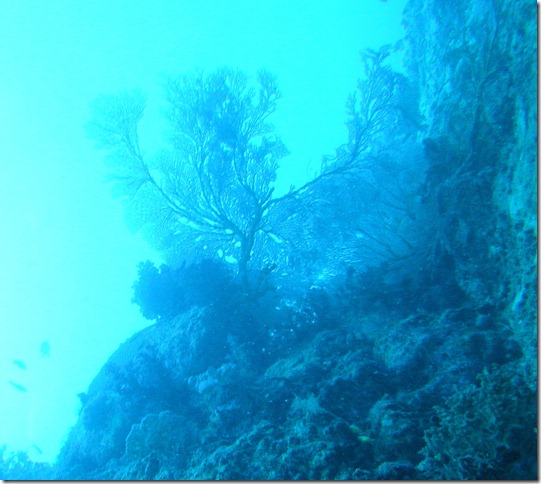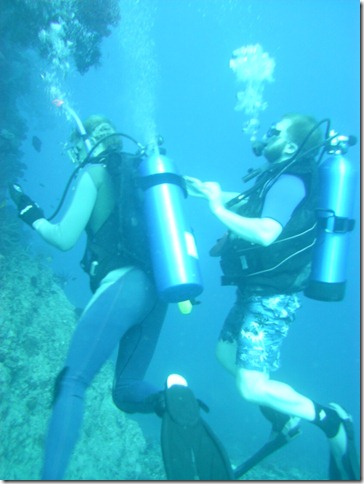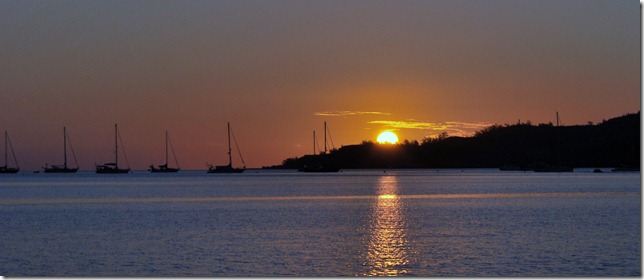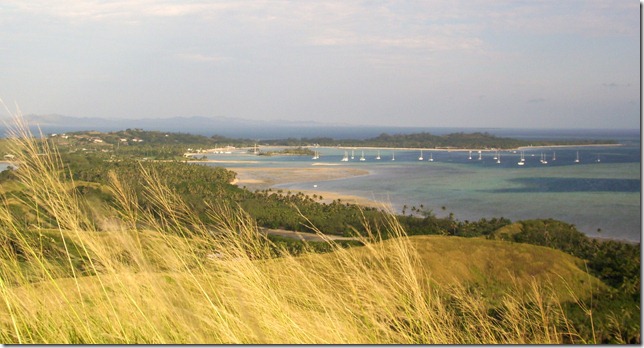The next day, everyone enjoyed a good snorkel in the clear water while I filled dive tanks. We’d seen numerous dive boats on moorings out near the reef and by the early afternoon we were headed out to have our first dive in Fiji, but not before I got a chance to refresh my free diving skills. The anchor was stuck under a coral head, and after several attempts to dislodge it failed, I ended up free diving the 25-30 ft to pull it loose by hand. I was pretty surprised that I was able to make it down on the first dive of the year, but it actually wasn’t too bad. The lagoon is large enough that there was a pretty good swell to deal with when we finally found a mooring atop a large, natural underwater tower and picked it up.
James joined Lauren and I for the dive, and between needing a little more weight for James and the rough conditions on the surface, it took us 5-10 tiring minutes to finally get in position and drop down. We hadn’t been diving since Tonga, and the first sensation was just how incredibly peaceful it is underwater. We’re fairly comfortable diving now, and it’s so nice to be able to relax and enjoy things. I don’t think we were in the best spot for soft coral, but we still saw lots of large fans and a big variety of other soft corals, including one that looked like pinkish, transluscent bubbles. Even though we’re somewhat used to them, it’s always amazing to see the many different species of bright and colorful reef fish. Even if we had a good Pacific reef fish book, it would take pages and pages just to cover all the species of fish from a single dive.
After diving, we headed out of the lagoon and started an overnight offshore sail to our next destination, the beautiful Mamanuca islands on the western side of Fiji. The Mamanucas are home to many of Fiji’s resorts and feature lots of clear water and miles of beaches. We made our way through the fringing reef to the south at Wilkes passage with a large swell from the south breaking on the reefs beside us and an exclusive surf resort on a tiny island covered in sand and palm trees to our right. Our first stop was Musket Cove, which is one of the popular spots for cruisers in Fiji. After winding our way into the cove, we picked up a mooring in 45′ of turquoise water surrounded by sandy beaches and the picturesque hills of Malolo Island immediately north of us. Lauren and Ashley were in water in minutes. It’s been hot & humid, and regularly swimming in the 82 degree water is the perfect remedy.
Even though Musket Cove is a full resort, they also cater to cruisers in several ways. They have a small marina, a mooring field, and a "Yacht Club". Lifetime membership in the yacht club is $0.50 US for the skipper and $2 .50 for any crew who have sailed to Musket Cove from a foreign port or are sailing from Musket Cove to a foreign port. Membership entitles you to use the facilities, so with a little fudging for James & Ashley, we’re all lifetime members. One of the best features of Musket Cove is the nightly barbecues. You can bring your own food or buy a prepared meal from the store complete with meat or veggies, garlic bread, a potato, and salad. The resort provides the beachfront bar, grills, fires, plates, forks, condiments, and best of all: dishwashing. It was a good night.
Just when we thought the night was winding down, we met some Aussies on a sort of family wedding vacation who had rooms at the neighboring resort and a full bar that they’d purchased with the rooms and had to leave behind when they were flying out the next day. The turned out to be great people, and we enjoyed talking with them and enjoying the resort’s pool until quite sometime the next morning.
After a night like that, we were a bit slow getting around and our plans for the day slowly became less ambitious. We did manage to catch up on internet time and also make a trip to the neighboring island. Musket Cove Resort is actually on Malolo Lailai Island, but the mooring field is between Malolo and Malolo Lailai. At low tide, you can walk between the islands and we took some time in the afternoon to make the walk to Malolo and visit a village inhabited by Fijians from the remote eastern Fiji Lau Group who are well known wood carvers. They showed us a variety of Kava bowls, bird carvings and other crafts. After making our selections we asked about climbing to the hilltop and in typical village fashion, they called over a couple of boys to show us the way to a neighboring hilltop. The 20 minute hike wasn’t too difficult, but the view was great. The shades of blue in the water always look so captivating from above. On the way back, we asked the boys if it would be possible to get a couple of green drinking cocunts. I’d been looking forward to one, and most of the crew had never tasted one. The boys found a small tree where we could reach the nuts and we twisted a couple off and then bashed one on the trunk of the tree to crack it open and let us drink the sweet water. It felt like it had been a long time coming, and it tasted great.
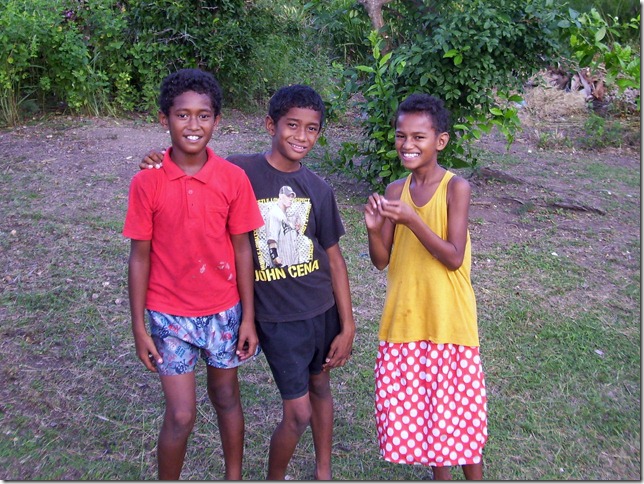 Our guides for the hike up the hilltop
Our guides for the hike up the hilltop
The walk back got us to the beach at sunset, but the tide had already been coming in for a couple of ours. We’d brought swim suits and scuba booties in anticipation and ended up needing them. We walked out a fair distance in knee to waist deep water over to the edge of the tidal flats where Ash and James (who’d swum out to the dinghy) met us and gave us a ride back to the boat.
The engine had died on Ash as he was motoring over to pick us up. I’d spent quite a bit of time trying to recover it, and had gotten a couple hours of good help from S/V Brickhouse in Suva, but it still wasn’t really reliable. It would run well for a while and then refuse to start, and often needed to be run at high RPMs. Yet another carb disassembly and pilot jet cleaning seemed to finally do the trick though, and we were finally able to set the idle nice and low and get it to start reliably. At this point, it’s really hard to imagine a few days going by without working on the outboard, but it seems to be good for now.


